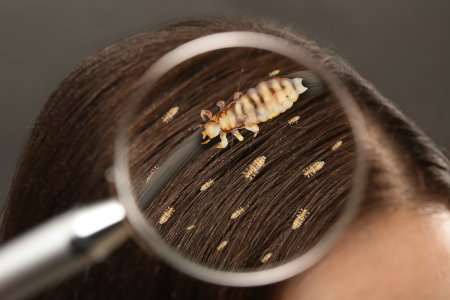Effective Head Lice Treatment NZ: Finding the Best Options

To address head lice concerns effectively, it is necessary to be informed and vigilant. Navigating the best options is crucial for a swift and successful resolution. We will provide you with the knowledge to move head lice solutions confidently and live a lice-free life. Let’s find the best treatment options for head lice in New Zealand.
In this blog post, we will guide you through successful head lice treatment options in New Zealand. It will help you fight head lice and recover your health using over-the-counter solutions, natural remedies, and preventive measures.
What Is Head Lice Menace?
Head lice are tiny, wingless insects that feed on human blood and mainly reside on the scalp. They spread easily through direct head-to-head contact and are commonly found in environments like schools or households.

The most common symptom of a head lice infestation is persistent itching along with red bumps on the scalp and tiny nits attached to hair shafts. Head lice infestations are not indicative of poor hygiene but rather a common occurrence.
The Head Lice Life Cycle
The maximum lifespan of a head louse from egg to mature adult is typically around 3 to 4 weeks. During this time head lice undergo various stages in their life cycle including the egg (nit) stage, nymph stage, and finally reaching adulthood.
The environmental conditions such as temperature and humidity play a crucial role in the duration of each stage. It’s important to note that head lice rely on human blood for sustenance and they are unable to survive for extended periods without a host.
How to Recognize Head Lice Symptoms?
Identifying the symptoms is crucial for early intervention. Look out for itching, red bumps on the scalp, and tiny, oval-shaped nits (lice eggs) attached to the hair shafts. Swift identification of symptoms is paramount for effective intervention.
- Persistent Itching: Persistent itching is the most common and recognizable symptom of a head lice infestation. Lice bites and saliva can cause an allergic reaction, leading to itching around the neck, ears, and scalp. While itching might not manifest immediately, a continuous, unexplained urge to scratch should raise suspicion.
- Red Bumps on the Scalp: As head lice feed on blood, their bites can result in small red bumps on the scalp. These bumps result from the body’s reaction to the lice’s saliva and are often mistaken for other skin conditions. Careful examination of the scalp especially in areas behind the ears and at the nape of the neck, can reveal these subtle yet indicative signs.
- Nits Tiny Oval-Shaped Eggs: Head lice eggs are another key symptom. These tiny oval-shaped eggs are attached to individual hair shafts near the scalp. While they may be mistaken for dandruff or debris, nits are more challenging to remove and tend to stick firmly to the hair.
- Adult Lice: While smaller and more challenging, adult lice may be visible. Adult lice are about the size of a sesame seed and are light brown to grayish-white in color.
- Secondary Signs: In more advanced cases, constant scratching can lead to sores and even bacterial infections on the scalp. Persistent itching can disturb sleep, affecting an individual’s overall well-being.
What is the Best Head Lice Treatment NZ?
First of all, if you want the best headlice treatment then you need an organic headlice product, which you can find at an organic grocery store. Now back to the How to get rid of head lice? The answer to this query is simple: Recognise head lice symptoms. Regular scalp checks, particularly in high-risk environments, enable early intervention and prevent the further spread of infestations. Following are the best head lice treatments for long thick hair, or short hair.
- Over-the-counter (OTC): Lice Shampoos typically contain pediculicides, chemicals designed to kill lice. Follow the instructions carefully and repeat the treatment if necessary.
- Natural Remedies: For those who prefer natural alternatives then natural products like tea tree oil, neem oil, or vinegar-based solutions can be effective. Home remedies for head lice may require more persistence.
- Prescription Medications: A healthcare professional might recommend prescription-strength medications in severe cases. These are potent and should be used under strict medical guidance.
- Fine-Toothed Combing: Combing out lice and nits with a fine-toothed comb is a manual but effective method. It requires patience and diligence but can be a chemical-free alternative.
How to Prevent Head Lice?
- Educate and Raise Awareness: Spread awareness about head lice in communities, schools, and households. Dispel common myths to reduce stigma and promote informed discussions.
- Avoid Head-to-Head Contact: Encourage individuals to avoid direct head-to-head contact, especially in crowded settings. Teach children to be mindful of personal space during activities where close contact is common.
- Regular Scalp Checks: Conduct routine scalp checks, especially after potential exposure or contact. Pay attention to itching, red bumps, or the presence of nits and lice.
- Tie Back Long Hair: Keep long hair tied back to minimize the risk of head-to-head contact. Braid or use a ponytail to reduce opportunities for lice to transfer.
- Educate Schools and Childcare Centers: Collaborate with schools and childcare centers to implement preventive measures. Promote regular checks and encourage timely communication about potential outbreaks.
- Launder Bedding and Personal Items: Wash bedding, hats, and clothing regularly, especially after potential exposure. Use hot water and high heat settings to effectively eliminate lice and nits.
- Teach Proper Hat and Coat Storage: In school or communal settings, educate children on proper hat and coat storage to minimize the risk of lice transmission.
- Encourage Open Communication: Foster an environment where individuals feel comfortable discussing potential head lice concerns. Prompt reporting allows for early intervention and prevention of further spread.




